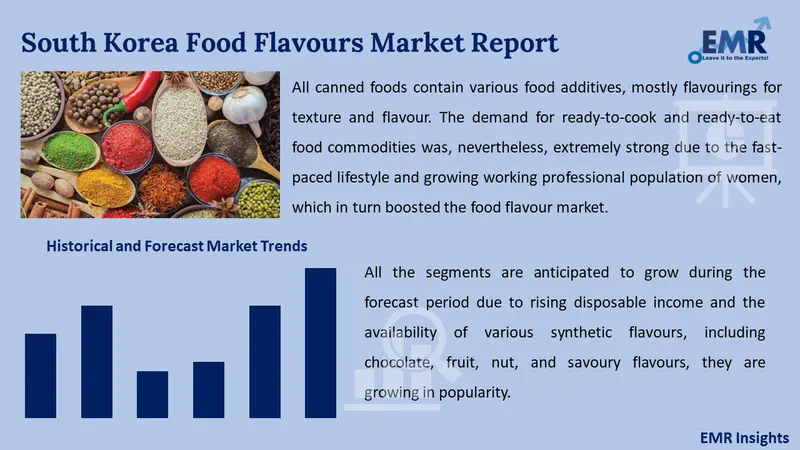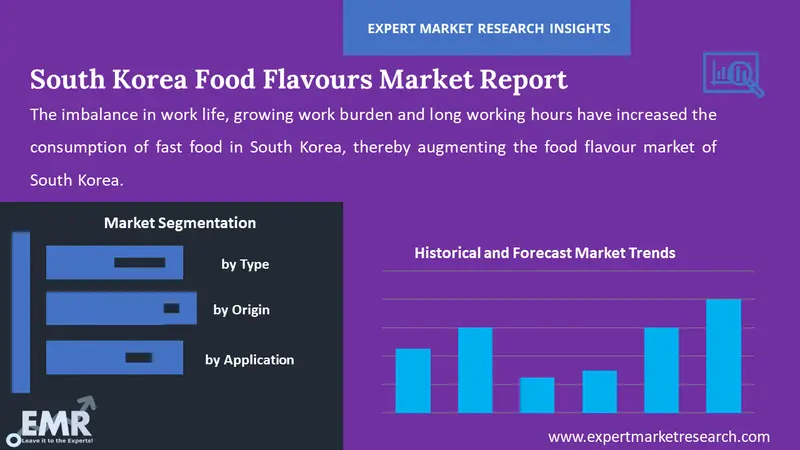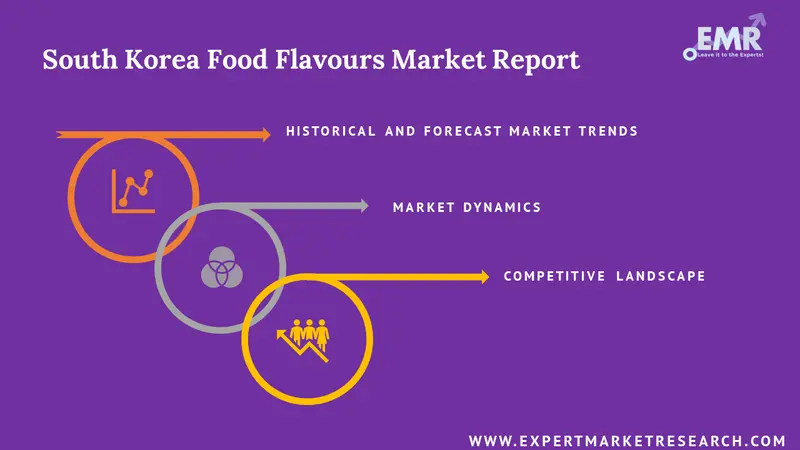
Consumer Insights
Uncover trends and behaviors shaping consumer choices today
Procurement Insights
Optimize your sourcing strategy with key market data
Industry Stats
Stay ahead with the latest trends and market analysis.
The South Korea food flavours Market size reached a value of more than USD 899.67 Million in 2025. The South Korea food flavour industry is expected to grow at a CAGR of 4.10% between 2026 and 2035, reaching a value of USD 1344.59 Million by 2035.
Base Year
Historical Period
Forecast Period
Compound Annual Growth Rate
4.1%
Value in USD Million
2026-2035
*this image is indicative*
A flavouring ingredient, similar to a food additive, that is used to improve the colour, flavour, or aroma of food is referred to as a food flavour. The natural flavour, synthetic flavour, and nature-identical flavouring categories make up the South Korean food flavour market. Flavours are primarily perceived by the senses of taste and smell and enhance the sensory impressions of food, food items, or other things. While maintaining the original flavour of foods, the flavour of food items may be readily changed by altering their aroma. Some great instances of this include flavoured jellies, beverages, confectionery and bakery products, and chocolates or candies that have a variety of flavours and hence have a variety of tastes and aromas.
The increased use of various forms of packaged or canned food commodities and drinks considerably fuels the South Korea food flavour industry. All canned foods contain various food additives, mostly flavourings for texture and flavour. The demand for ready-to-cook and ready-to-eat food commodities was, nevertheless, extremely strong due to the fast-paced lifestyle and growing working professional population of women, which in turn boosted the food flavour market. Over the past few decades, the labour market in Korea has seen significant changes. Korea's population today works far more high-skilled jobs in the service sector than it did when it was predominantly engaged in low-skilled, rural self-employment. The imbalance in work life, growing work burden and long working hours have increased the consumption of fast food in South Korea, thereby augmenting the food flavour market of South Korea.
Customers have been seeking foods and drinks that can meet their shifting demands since the COVID-19 Pandemic. Young consumers, especially millennials and generation Z seek food and drinks with the novel, adventurous, and exotic flavours. Some customers seek food and beverages that would provide them with the excitement and cultural discovery they would get from travelling. Customers appreciate novel, robust flavours in food and beverages because they prefer to stay at home and are searching for excitement. Consumers continue to like nostalgic flavours that make them feel good. In order to deal with the strain and stress brought on by the pandemic and other difficulties, consumers are seeking soothing, nostalgic, and sumptuous meals and beverages. This factor compels the manufacturers to invest in the development of new and improved flavours to meet the ever-changing palette of consumers, thereby propelling the food flavours market of South Korea.
The market for food flavours is primarily driven by the expanding demand for varied food applications, high living standards, and rising demand for processed foods and drinks with rising disposable incomes, among others. The need for compounded tastes is being further fueled by the rise in product releases with unusual and distinctive flavours.
The long-term health impacts of artificial substances and additives in food goods are raising concerns among South Korean consumers. Consumers, however, expect components that come from plants or are based on plants in order to help them lead healthy lives. As a result, the market for natural flavours is growing due to customer preference for clean-label flavouring components that don't include any harsh chemicals, thereby bolstering the growth of the South Korea food flavours market.

Read more about this report - REQUEST FREE SAMPLE COPY IN PDF
The EMR’s report titled “South Korea Food Flavours Market Report and Forecast 2026-2035” offers a detailed analysis of the market based on the following segments:
Market Breakup by Type
Market Breakup by Origin
Market Breakup by Application

Read more about this report - REQUEST FREE SAMPLE COPY IN PDF
The food flavour market of South Korea is bifurcated into chocolate and brown, vanilla, fruit and nut, and spice and savoury, among others. All the segments are anticipated to grow during the forecast period due to rising disposable income and the availability of various synthetic flavours, including chocolate, fruit, nut, and savoury flavours, they are growing in popularity. The surge of fusion dishes and inclination toward exotic flavours is aiding the growth of the spice and savoury segment in South Korea. Consumers, especially the MZ generation experiment to seek new experiences. This factor propels the key players to indulge in the innovation of new as well as nostalgic flavours, thereby boosting the growth of the food flavour market of South Korea.
Manufacturers of food and beverages invest heavily in research and development to create improved artificial tastes that are very safe to ingest. This is also anticipated to support the segment's revenue growth. The market for healthy natural flavours is expected to grow. Spices and herbal flavours like ginger, turmeric, and cinnamon are becoming more and more popular and are essential to the development of Ready-to-Drink (RTD) innovations that are health-focused. Comparing purity standards and combination uniformity, artificial tastes are thought to be safer for eating than natural flavours. Before being commercially offered for consumption, artificial tastes must pass rigorous testing to establish their safety, which has greatly aided this segment's revenue development.
Functional drinks and carbonated drinks consumption is growing due to the increased demand for low-sugar and salt-based diets among the South Korean population. The trend of such diets is increasing as they lead to the development of various chronic disorders such as cardiovascular diseases, high blood pressure, and diabetes, among others. The dairy, bakery and confectionery, industries are expected to grow considerably throughout the projection period. Dairy drinks and other dairy products usually contain a variety of tastes, such as fruit and nut flavours and natural spices. The industry is expected to grow as fruit and chocolate flavours become more popular in the dairy and confectionery sector leading to the development of the food flavour market in South Korea.

Read more about this report - REQUEST FREE SAMPLE COPY IN PDF
The company Symrise AG (Symrise) sells flavours and perfumes. The business creates, manufactures, and markets flavourings, perfumes, active components and raw materials for cosmetics, as well as functional ingredients and solutions. It offers the health and personal care industries chemicals and compounds that are useful and bioactive. It is active in Latin America, Europe, Africa, the Middle East, and the Asia-Pacific region. German company Symrise AG, which was established in 1874, has its headquarters in Holzminden.
The Group produces and distributes cutting-edge flavour solutions as well as dietary and functional components for the pharmaceutical, food, and beverage sectors. The Group also produces frozen meals with client brands and added value brands for the consumer food markets in the UK and Ireland. The firm offers food goods through a variety of retailers, convenience shops, and e-commerce channels in a few regions while selling ingredients and nutritional products throughout Europe, the Middle East, Africa, the Americas, and Asia-Pacific. Kerry Group is headquartered in Tralee, Ireland.
*Please note that this is only a partial list; the complete list of key players is available in the full report. Additionally, the list of key players can be customized to better suit your needs.*
Other key players in South Korea food flavour market are Robertet Korea, Huabao International Holdings Limited, Givaudan International SA , International Flavors & Fragrances Inc., Firmenich SA. among others.




*While we strive to always give you current and accurate information, the numbers depicted on the website are indicative and may differ from the actual numbers in the main report. At Expert Market Research, we aim to bring you the latest insights and trends in the market. Using our analyses and forecasts, stakeholders can understand the market dynamics, navigate challenges, and capitalize on opportunities to make data-driven strategic decisions.*
Get in touch with us for a customized solution tailored to your unique requirements and save upto 35%!
In 2025, the South Korea food flavour market attained a value of nearly USD 899.67 Million.
The market is projected to grow at a CAGR of 4.10% between 2026 and 2035.
The market is estimated to witness a healthy growth in the forecast period of 2026-2035 to reach USD 1344.59 Million by 2035.
Continuous research and development, the growing demand for nostalgic, exciting and exotic flavours, rising disposable income, and high living standards are the major drivers in the South Korea food flavour market.
The growing demand for ready-to-eat foods and beverages and the surge of natural plant-based and clean-labelled food flavouring products are the key industry trends.
The dominant types of food flavours in the industry are chocolate and brown, vanilla, fruit and nut, and spice and savoury, among others.
The major players in the industry are Symrise AG, Robertet Korea, Kerry Group plc., Huabao International Holdings Limited, Givaudan International SA, International Flavors & Fragrances Inc., and Firmenich SA., among others.
Explore our key highlights of the report and gain a concise overview of key findings, trends, and actionable insights that will empower your strategic decisions.
| REPORT FEATURES | DETAILS |
| Base Year | 2025 |
| Historical Period | 2019-2025 |
| Forecast Period | 2026-2035 |
| Scope of the Report |
Historical and Forecast Trends, Industry Drivers and Constraints, Historical and Forecast Market Analysis by Segment:
|
| Breakup by Type |
|
| Breakup by Origin |
|
| Breakup by Application |
|
| Market Dynamics |
|
| Competitive Landscape |
|
| Companies Covered |
|
Single User License
One User
USD 3,999
USD 3,599
tax inclusive*
Datasheet
One User
USD 2,499
USD 2,249
tax inclusive*
Five User License
Five User
USD 4,999
USD 4,249
tax inclusive*
Corporate License
Unlimited Users
USD 5,999
USD 5,099
tax inclusive*
*Please note that the prices mentioned below are starting prices for each bundle type. Kindly contact our team for further details.*
Flash Bundle
Small Business Bundle
Growth Bundle
Enterprise Bundle
*Please note that the prices mentioned below are starting prices for each bundle type. Kindly contact our team for further details.*
Flash Bundle
Number of Reports: 3
20%
tax inclusive*
Small Business Bundle
Number of Reports: 5
25%
tax inclusive*
Growth Bundle
Number of Reports: 8
30%
tax inclusive*
Enterprise Bundle
Number of Reports: 10
35%
tax inclusive*
How To Order

Select License Type
Choose the right license for your needs and access rights.

Click on ‘Buy Now’
Add the report to your cart with one click and proceed to register.

Select Mode of Payment
Choose a payment option for a secure checkout. You will be redirected accordingly.
Gain insights to stay ahead and seize opportunities.

Get insights & trends for a competitive edge.

Track prices with detailed trend reports.

Analyse trade data for supply chain insights.

Leverage cost reports for smart savings

Enhance supply chain with partnerships.

Connect For More Information
Our expert team of analysts will offer full support and resolve any queries regarding the report, before and after the purchase.
Our expert team of analysts will offer full support and resolve any queries regarding the report, before and after the purchase.
We employ meticulous research methods, blending advanced analytics and expert insights to deliver accurate, actionable industry intelligence, staying ahead of competitors.
Our skilled analysts offer unparalleled competitive advantage with detailed insights on current and emerging markets, ensuring your strategic edge.
We offer an in-depth yet simplified presentation of industry insights and analysis to meet your specific requirements effectively.
Share